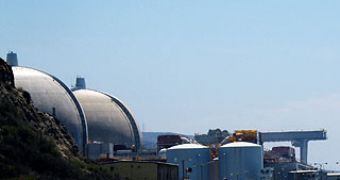During nuclear fission reactions nuclear power plants produce a by-product element known as plutonium, which accumulates on the uranium fuel rods. Plutonium cannot occur naturally on Earth and is extremely important for the fabrication of nuclear bombs because it is used in the detonation mechanism initiating the nuclear fission reaction. Plutonium accumulation of the fuel rods is also extremely hard to track.
International Atomic Energy Agency inspectors have to monitor carefully the operation of the reactor and compare their findings with the results of the operators to make certain that the entire quantity of plutonium by-product is reported by the latter. This usually involves monitoring the amount of coolant circulated through the reactor, which is somehow difficult because the installed sensors require expensive cables, both hard to install and to maintain in the radioactive environment.
An alternative solution developed at the Lawrence Livermore National Laboratory in collaboration with the Sandia National Laboratories can monitor the quantity of plutonium by simply supervising the number of antineutrino particles generated during the nuclear fission reaction. Not only that this would provide more accurate measurements, but the required instruments are relatively simple to build, inexpensive and don't need to be placed inside the reactor itself.
Antineutrinos are the antiparticles of neutrinos. The latter are particles with zero electrical charge, bearing an extremely small, yet unknown mass, presenting weak interactions with normal matter. The neutrinos are still believed to be a constituent part of dark matter, although the Standard Model puts them in the Fermion family, as Leptons, the group containing the electrons. Several billion neutrinos originating from the Sun are believed to pass through a human body every second.
Antineutrinos are generated during nuclear fission reactions. Six antineutrinos are generated for each fissioning uranium atom, which can be captured and counted with the help of an antineutrino detector. These detectors are usually made of either solid or liquid proton rich substances, which decay when interacting with an antineutrino particle. The decay of the proton is signaled by the emission of photon particles of light.
"It's very hard to make signals that look like an antineutrino without a reactor", says Adam Bernstein, deputy group leader of the Advanced Detectors Group. Three years ago Bernstein and his colleagues installed such an antineutrino detector at the San Onofre Nuclear Generating Station, consisting of a mix of 640 kilograms of mineral oil and 1,2,4-trimethylbenzene, and have now reported that the monitoring method has a 3 percent accuracy.
"The results at San Onofre show it could be a deployable instrument in certain circumstances", said IAEA safeguard technology specialist Andrew Monteith.
The detector is now expecting IAEA evaluation, albeit it may encounter some problems since the current detector mix is highly toxic and flammable. Furthermore, the fact that it detects antineutrino means that it must be placed underground, which may not be possible for some facilities.

 14 DAY TRIAL //
14 DAY TRIAL //